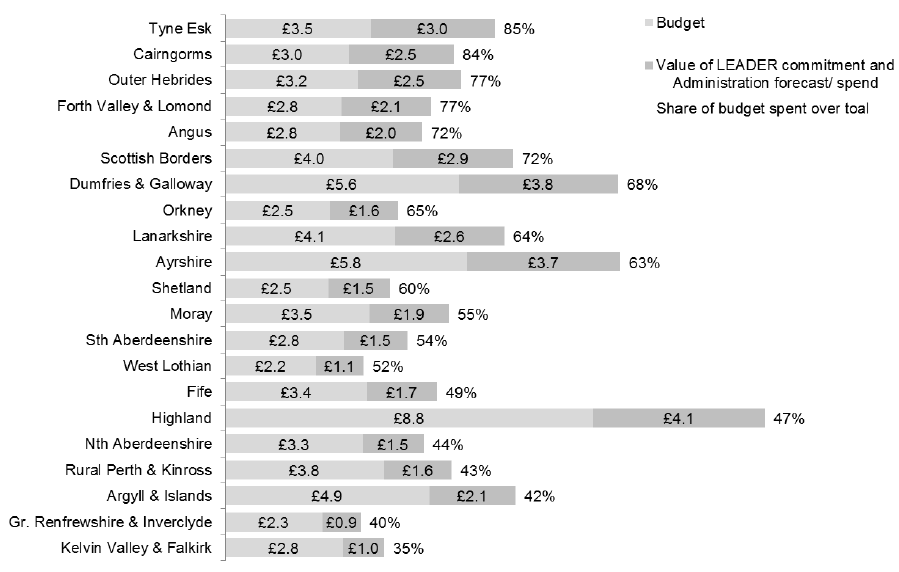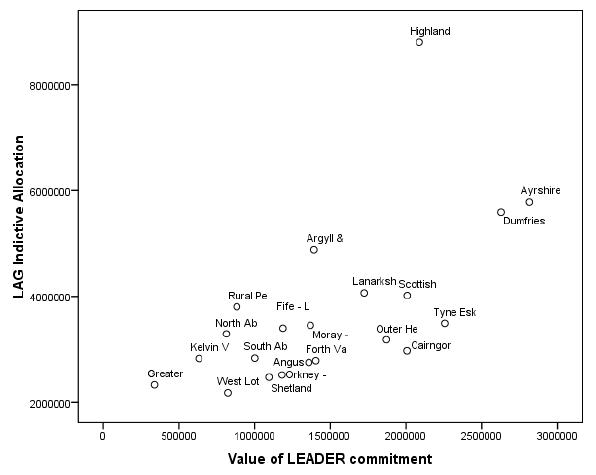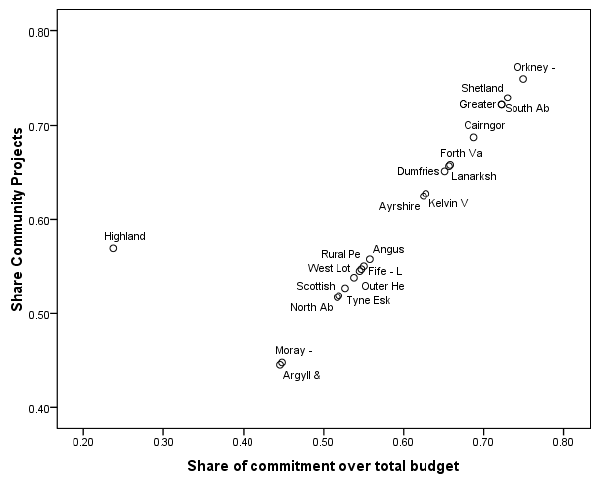LEADER 2014-2020: process evaluation
Initial process evaluation for LEADER 2014-2020 and assessment of its economic, social, cultural and environmental impact on rural communities.
Local Action Groups – An overview of budgets and projects approved
This research project was divided into two phases – an analysis of administrative data on the Local Actions in Rural Communities system (LARCs) and secondly, the collection and analysis of qualitative data generated through focus groups in four Local Action Groups (LAGs). In phase one, the LEADER database LARCs was accessed in order to extract data at the LAG level. Findings of this rather macro-level approach were then used to identify LAGs that are likely to represent a diverse range of projects, challenges and outcomes. Whilst for the selection of the focus groups, data was extracted from LARCs on the 26th of February to allow for enough time to organise, conduct and transcribe the focus groups, the analysis in the following section is using data extracted on the 18th May 2018 to ensure higher accuracy for the purpose of the report.
Because the current LEADER programme 2014-2020 has not been completed yet, quantitative data on the outcomes of the projects is limited. Table 1 lists all 21 Scottish Local Action Groups, their indicative allocation and more importantly the value of LEADER commitments so far. Table 1 also includes the number of project applications overall and the number of approved projects. Based on these figures, the average project value was calculated and the relative share of committed budgets over allocation and approved projects over all applications. Data was extracted on the 18th May 2018 from LARCs (Local Actions in Rural Communities system).
Based on table 1, we know that the overall budget for all 21 Scottish LAGs is £77.4 million of which 40% so far have been committed to projects. Of 1137 applications, 495 (44%) have been approved. Of all projects, only 59 (12%) had been completed or at the stage of final claims made at the time data was extracted. Whilst LARCs asks projects to report a number of outcomes that will help to capture economic, social, cultural and environmental impact, data at this stage is very limited due to the low share of completed projects. Consequently, no conclusions can be made yet solely based on data collected on LARCs.
Table 1 LAG budget, commitments and applications4
| Local Action Groups | LAG Indictive Allocation | Value of LEADER commitment | *Admin & Animation (A&A)(ACTUAL spend + forecast) | Share commitment over budget | Total no. of applications | Number of approvals | Approved applications over total |
|---|---|---|---|---|---|---|---|
| Angus | £2,750,186 | £1,358,210 | £662,486.22 | 49% | 42 | 27 | 64% |
| Argyll & Islands | £4,886,126 | £1,393,274 | £613,095.65 | 29% | 83 | 22 | 27% |
| Ayrshire | £5,783,731 | £2,818,007 | £845,672.96 | 49% | 120 | 37 | 31% |
| Cairngorms | £2,968,517 | £2,006,580 | £492,419.75 | 68% | 32 | 26 | 81% |
| Dumfries & Galloway | £5,595,370 | £2,629,668 | £1,169,927.27 | 47% | 87 | 44 | 51% |
| Fife | £3,397,670 | £1,187,623 | £471,697.84 | 35% | 43 | 19 | 44% |
| Forth Valley & Lomond | £2,783,013 | £1,404,959 | £738,862.18 | 50% | 40 | 30 | 75% |
| Gr. Renfrewshire & Inverclyde | £2,324,196 | £337,184 | £581,048.98 | 15% | 34 | 6 | 18% |
| Highland | £8,805,388 | £2,088,743 | £2,013,187.19 | 24% | 79 | 43 | 54% |
| Kelvin Valley & Falkirk | £2,824,399 | £631,662 | £349,953.39 | 22% | 43 | 15 | 35% |
| Lanarkshire | £4,066,953 | £1,724,030 | £887,073.84 | 42% | 34 | 19 | 56% |
| Moray | £3,453,040 | £1,368,729 | £517,864.23 | 40% | 29 | 11 | 38% |
| Nth Aberdeenshire | £3,290,237 | £812,465 | £641,539.77 | 25% | 29 | 9 | 31% |
| Orkney | £2,512,250 | £1,181,381 | £586,355.19 | 47% | 40 | 21 | 53% |
| Outer Hebrides | £3,177,666 | £1,871,917 | £444,744.05 | 59% | 84 | 29 | 35% |
| Rural Perth & Kinross | £3,800,124 | £882,205 | £735,381.84 | 23% | 69 | 26 | 38% |
| Scottish Borders | £4,018,427 | £2,007,987 | £523,473.60 | 50% | 77 | 38 | 49% |
| Shetland | £2,467,085 | £1,093,988 | £866,814.72 | 44% | 37 | 18 | 49% |
| Sth Aberdeenshire | £2,831,742 | £1,001,041 | £374,451.80 | 35% | 54 | 14 | 26% |
| Tyne Esk | £3,490,769 | £2,256,025 | £698,361.39 | 65% | 55 | 31 | 56% |
| West Lothian | £2,173,112 | £822,482 | £314,915.33 | 38% | 26 | 10 | 38% |
| Totals | £77,400,001 | £30,878,159 | £14,529,327.19 | 40% | 1137 | 495 | 44%[4] |
The overall budget allocated to 21 Scottish LAGs between 2014-2020 is £77.4 million of which the highest budget is allocated to the Highland LAG with £8.8 million and the lowest to West Lothian £2.2 million. The average budget is £3.7 million. At the time data was extracted (18th May 2018), LAGs had committed £30.9 million of their budget to LEADER projects. In other words, 40% of the budget had been approved to projects. LAGs can spend up to 25% of their budget on administration and animation and table 1 lists the administration budget spent and forecasted.
Figure 4 below takes spending on administration and animation into account and indicates the share of LEADER commitments and administration costs over the total budget. However, because spending on administration and animation is based on estimated spending, for the purpose of this analysis only actual project commitments are taken into account. Thus, it needs to be kept in mind that all figures describing the share of commitments over value exclude administration costs that can make up to 25% of the overall budget.
Figure 4 Value of LEADER commitments and allocated budgets – including administration costs (forecast and spend)

Extracted from LARCs on 18 May 2018
The value of LEADER commitments over the total available budget ranges from 15% in Greater Renfrewshire (here £337,184 of £2.3 million were committed to projects by the 18th of May 2018) and Cairngorms with 68% (£2 million committed of £3 million budget). The following LAGs have committed less than a third of their budget: Argyll and Islands (29% of their overall budget of £4.9 million); North Aberdeenshire (25% of their overall budget of £3.3 million); Highland (24% of £8.8 million); Rural Perth and Kinross (23% of £3.8 million); Kelvin Valley and Falkirk (22% of £2.8 million) and Greater Renfrewshire (15% of £2.3 million). On the other hand, the following LAGs have committed around 60% or more of their budget: Cairngorms (68% of £3 million); Tyne Esk (65% of £3.5 million) and Outer Hebrides (59% of £3.2 million).
Figure 5 below illustrates that as expected the higher the LAG overall budget, the higher the value of commitments at this point are. This relationship is statistically significant and even though this was to be expected, the figure below shows outliers. More or less all LAG follow a linear trend in that the more budget they have got available, the more they have committed to by this point in time. However, the LAG Highland does not follow this linear trend and despite having by far the largest budget, the value of commitments lags behind. When taking out the LAG from the dataset, we see this very clearly as the correlation coefficient increases from 0.6** to 0.7**. In other words, the association between higher budgets and higher commitments is even stronger when we leave out the LAG Highland. This observation is particularly interesting because not only does the LAG have the largest budget and has only spent a quarter at this point, but it also is the only LAG that is divided into Local Area Partnerships (LAP). Due to the size of the LAG, seven LAPs deliver a specific Local Area Action Plan, manage their local budget and make decisions on local projects that seek LEADER funding. Once, the programme has finished, it should be reviewed to see whether the LAG has managed to spend its budget and how and what impact the LAPs have had on the commitment process.
Figure 5 Value of LEADER commitments over overall LAG budget[5]

By May 2018, 1137 project applications had been submitted to LAGs across Scotland. Of these 1137 applications only 44% or 495 applications had been approved. This means that 56% of all applications were either rejected, withdrawn, required additional work, were on hold or in process or still at the draft stage.
Ayrshire has received the highest number of applications with 120 in total compared to West Lothian with 26. The lowest share of approved projects over total applications are in Greater Renfrewshire and Inverclyde with an approval rate of 18%. This reflects the observation that in the LAG the share of LEADER commitments is also comparably lower than anywhere else. One reason for this might be that in the LAG 12 projects have been withdrawn, rejected or require rework which is a relatively high number considering the LAG has one of the smallest budgets. The reason for the low share of commitment and approved projects could also lie in the fact that the LAG has the second lowest budget. However, West Lothian with a smaller budget has committed 38% of its budget to LEADER projects. On the other extreme we find Cairngorms with an approval rate of 81%. Here, 26 out of 32 applications were approved. This LAG also has the highest share of commitments as well. Here, we find that just 2 applications had gotten rejected, none require being reworked and 4 had been withdrawn.
Unsurprisingly, when plotting the number of approved projects with the share of LEADER commitments, we find a positive association. In other words, LAGs that have approved more projects also have spent a higher share of their budget (correlation coefficient of 0.8**) and have also received more applications in general (0.7**). At this stage, this report cannot establish what factors positively impact the share of commitment or approved projects for each LAG. This is because only a small share of the overall budget has been committed and data is not available yet.
Whilst the share of LEADER commitments over the overall budget is not correlated with the number of applications, the commitment rate however is strongly dependent on the type of projects a LAG approves. We find that the commitment rate is significantly higher if a LAG has accepted relatively more community projects. On the other hand, LAG that have a relatively high number of farm diversification and business projects tend to have committed less of their budget. The figure below shows this statistically significant relationship (correlation coefficient of 0.8**). The reasons for this could be either that farm diversification and business applications are more onerous for the LAG staff or that they tend to apply for smaller grants than community funds. While at this stage, it cannot be clearly established why the share of committed budget depends on the type of project, the difference needs to be highlighted.
Figure 6 Value of LEADER commitments over overall LAG budget[6]

The main focus of this report therefore is not how LAGs perform, but how the projects that are currently live or completed have had an impact on life in rural Scotland. Using the findings from the four focus groups conducted, the following section starts with an evaluation of the economic impact LEADER funded projects have had.
Contact
Email: Eva Kleinert
There is a problem
Thanks for your feedback